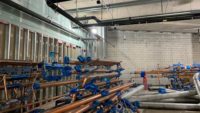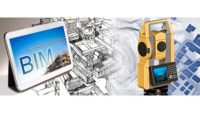I am fortunate to work in an industry and with an organization that is grounded in a safety and help culture. We are always looking for safe, new, improved and more efficient ways to install systems and components, and where this can support the project delivery and success of our trade partners.
A huge part of mechanical and plumbing system scope involves piping installations. With the fluctuating markets and the commodity pricing changes we experience, our team is zooming in on how we can build projects more efficiently and at a lower cost. There is a growing number of developing and new engineered piping applications that are commonly used in the markets we serve. We recommend piping alternatives (based on what’s specified) that should be considered as options or for labor and material savings where the piping application is listed for the application or approved by the local authority. I like to reference the ASHRAE Handbooks when evaluating design alternatives and approved practices. In this article, I reference the 2021 Fundamentals Handbook — I highly recommend that all industry professionals have access to this library of guidebooks.
Most of the larger hydronic systems we are installing feature carbon steel piping along with other pre-engineered and pre-insulated piping systems. These installations include chilled water and heating water delivery. Oftentimes, these larger systems are modeled ahead of construction, and the prefabrication effort is enabled where labor hours can be shifted to the left on our project schedules. There are different types of steel piping and joining methods that may be utilized — seamless pipe (Type S) has no longitudinal seam, ERW piping is very common where an electric current welds a longitudinal seam on a cylindrical sheet or strip of steel to bring the edge together. ERW is more economical and much more accepted than it was decades earlier due to the improved technologies and quality. Welded systems do not age or dry out as gasketed systems will and provide maximum long-term reliability. ASTM standards such as A53 specify steel pipe A and B grading. Type A grade has a lower tensile strength and is not widely used or specified.
We should be more open to using these mechanical press systems when welding and hot work are a concern, especially in retrofit work where welding gases may be an issue in occupied spaces or system downtime must be minimized. Compared to threaded and coupled systems, press systems for natural gas are routinely tested and pass with no problems and the labor savings is real.
It’s also common to see grooved systems being utilized. These are available and applicable to steel, cast iron, ductile, copper and plastic piping. I see grooved piping utilized on condenser water, chilled water and heating water systems very often. It’s important to follow the manufacturer’s guidelines on bolt setup and torque requirements. The use of impact wrenches on these systems seems normal or commonplace, but not all grooved systems are rated for the use of these tools. I’m aware of a large grooved job where the fastening bolts were stretched using impact wrenches and the bolt lost elasticity, a necessity to help keep the fastener tightened. This condition is similar to the bolts, lugs and the safety of the wheel of your car, where exceeding the recommended torque can cause the bolt to fail to “pull back” on the wheel and secure it on the car when properly tightened. This chilled water system suffered from extensive leaks during testing and through initial operation, leading to a full-blown effort to replace the fittings and properly secure them to the manufacturer’s standards. The latest generation of grooved products are being designed for installation using impact wrenches. I like the way we use grooved systems to provide for expansion and flexibility/vibration isolation in systems and directly at equipment. This is a very efficient and effective approach to this requirement during operation and temperature changes.
For nonmetallic or plastic piping, the temperatures, pressures, fluid properties and stresses the piping will be exposed to must be considered in the application, and not all plastic piping systems are suitable for higher-temperature applications. Fusion weld systems are common on larger and high-pressure HDPE piping systems, and other types of plastics include PVC, CPVC and PE pipe.
Mechanical press systems are becoming more utilized and more common. Copper press systems are seen regularly on domestic water systems and smaller-diameter heating water systems. I like these press systems when long straight runs and risers are laid out in design. There are press systems that can be used on natural gas, fuel oil and process gas piping. This may be new to some facility owners or engineering teams, but these press systems are in fact UL approved to be enclosed in mechanical chases and work very well in riser work. We should be more open to using these mechanical press systems when welding and hot work are a concern, especially in retrofit work where welding gases may be an issue in occupied spaces or system downtime must be minimized. Compared to threaded and coupled systems, press systems for natural gas are routinely tested and pass with no problems and the labor savings is real.
Refrigerant piping is graded specifically for the “ACR” application and is “clean and capped” for installation. Many of our projects use DX equipment for heating and cooling and may be straight cooling, heat pump or variable volume refrigerant-based. I see some specifications that require rigid-type ACR copper and others that allow soft copper tubing to be used. It’s important to know what the manufacturer’s requirements are with respect to piping when different equipment is being installed than the basis of the designed system. On VRF installations, certain parts of the system are required to be rigid copper tubing and other parts can be installed using rolled ACR-grade copper. High-temperature brazing may be a preferred joining method by many contractor teams but flared connections are often used to make up equipment connections. Flared connections require different torque requirements based on the pipe diameter, and care must be taken to meet the exact torque requirements to ensure a proper seal as well as avoid damage on the flare joint. When brazing, a nitrogen purge is required to prevent oxidation and scaling inside the piping, contaminating the system. On large DX installations, we require testing logs and diligent field testing of all field joints, and we usually refer to the manufacturer's instructions on testing requirements for pressure levels and durations.
Pipe hangers and supports are established by ASME B31 standards for the design of pipe-supporting elements. Adequate and sufficient supports are something we inspect in the field for installation correctness (compliance) and long-term operation of the system. Hangers support the piping from above, and supports bear the weight of the piping from below. There are also pipe restraints, such as guides and anchors, that limit or direct the movement of piping as well as load support. Larger piping systems may require or have the design of the supports delegated to a design professional. A qualified engineer should design or review all anchors and supporting elements for the following systems:
- Steam systems operating above 15 psig;
- Hydronic systems operating above 160 psig or 250° F;
- Risers over 10 stories or 100 feet;
- Systems with expansion joints, especially piping above 3 inches in diameter;
- Pipe sizes over 12-inch diameter;
- Anchor loads greater than 10,000 pounds; and
- Moments on pipe and structure in excess of 1,000 foot-pounds.
Support spacing and rod sizes vary for different piping systems. Table 11 in the 2021 ASHRAE Fundamentals Handbook is a guide used in code applications. Your local AHJ may require something different and should be consulted. Our field QCQA routinely checks for supports located at required intervals, adjacent to joints, branch connections and adjacent to changes in direction, in both the vertical and horizontal directions.
Piping and equipment loads — all mechanical loads really — and the attachments to structure should be communicated to and coordinated with the structural engineer of record. Building structure design must take into account the system loading that is going to take place.
Pipe sizing guidelines, pressure loss recommendations, velocity limits for energy, noise and erosion control, and many other aspects of pipe design are fundamental to piping system layouts and installation. Please reach out to me or any of your PM industry professionals if we can support you in any way!




